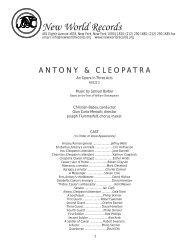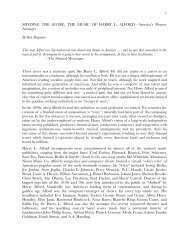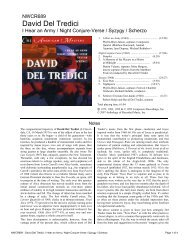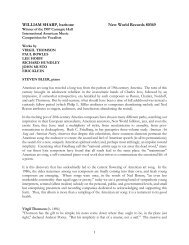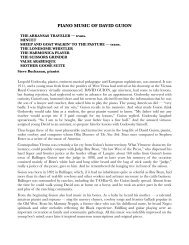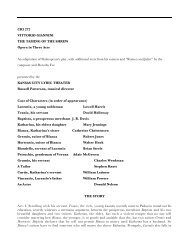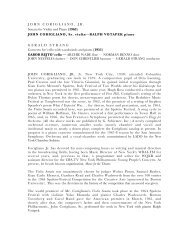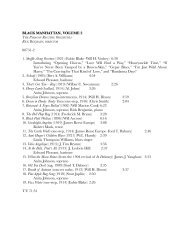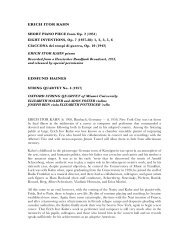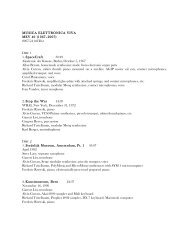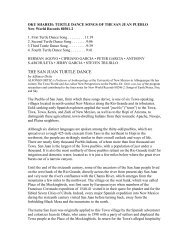Brother, Can You Spare a Dime? - New World Records
Brother, Can You Spare a Dime? - New World Records
Brother, Can You Spare a Dime? - New World Records
Create successful ePaper yourself
Turn your PDF publications into a flip-book with our unique Google optimized e-Paper software.
Gene Autry, born in Tioga, Texas, in 1907, recorded “The Death of Mother Jones” at the<br />
beginning of his career, in 1931. He worked as a railroad telegrapher in Oklahoma,<br />
whiling away lonely hours by singing the songs of his idol, Jimmie Rodgers. With the<br />
onset of the Depression, Autry went to <strong>New</strong> York to seek a singing career, encouraged by<br />
complimentary remarks made by a passenger on a train stopping briefly at his station; the<br />
passenger was Will Rogers. Success came quickly. By late 1929 Autry was recording<br />
commercially for several companies, and in 1930 he went to Chicago as a featured<br />
performer on the newly popular WLS National Barn Dance. His first hit record, “That<br />
Silver Haired Daddy of Mine,” came out in 1931, and in a few more years he was a top<br />
Hollywood star, with his new image of “singing cowboy” contributing to his success.<br />
The origin of “The Death of Mother Jones” is obscure; Autry said that he learned it from<br />
his agent, William R. Calaway. Its stanzaic, repetitious, pentatonic nature suggests that it<br />
may be an Anglo-American folk song fitted with topical words. It speaks of the career of<br />
Mother Jones in quite general terms (“In ev’ry mining town,/ Mother Jones was ready to<br />
help them,/She never turned them down”), rather than referring to specific strikes. There<br />
is clear implication that what she had done could serve as a model for labor activists of<br />
the Depression years (“May the miners all work together/To carry out her plan,/And<br />
bring back better conditions/For every laboring man”).<br />
All I Want<br />
(Millard Lampell, et al.)<br />
The Almanac Singers and Pete Seeger. Recorded 1941. Originally issued on Keynote<br />
304.<br />
Pete Seeger (born 1919), who had dropped out of Harvard in order to roam around<br />
America, play his banjo, and expand his repertory of folk songs, teamed up with Lee<br />
Hayes (a former Commonwealth College organizer, born in rural Arkansas) for an<br />
evening of their brand of folk songs in Greenwich Village in late 1940. With Millard<br />
Lampell, a writer who had graduated from the University of West Virginia, they became<br />
the Almanac Singers and gave an impromptu performance for the National <strong>You</strong>th<br />
Congress in Washington that same year. Hayes explained the choice of the group’s name:<br />
“. . . if you want to know what’s good for the itch, or unemployment, or Fascism, you<br />
have to look in your Almanac. That’s what Almanac stands for” (People’s Songs Bulletin<br />
3, November, 1948). The three had similar political views and shared a conviction that<br />
working-class Americans could best be told of the evils of capitalism through music of a<br />
sort already known to them.<br />
The Almanacs became a quartet in the early summer of 1941 when Woody Guthrie<br />
joined them, and they traveled across America later that summer, singing at union<br />
meetings from <strong>New</strong> York to California. Other musicians would join them from time to<br />
time, and at one point the makeup of the Almanacs was so flexible that several groups<br />
with the name would perform at different places at the same time.<br />
Their album Talking Union consisted of six of their most political songs. Lampell wrote<br />
most of the lyrics, though both words and music represent collaboration by several of the



